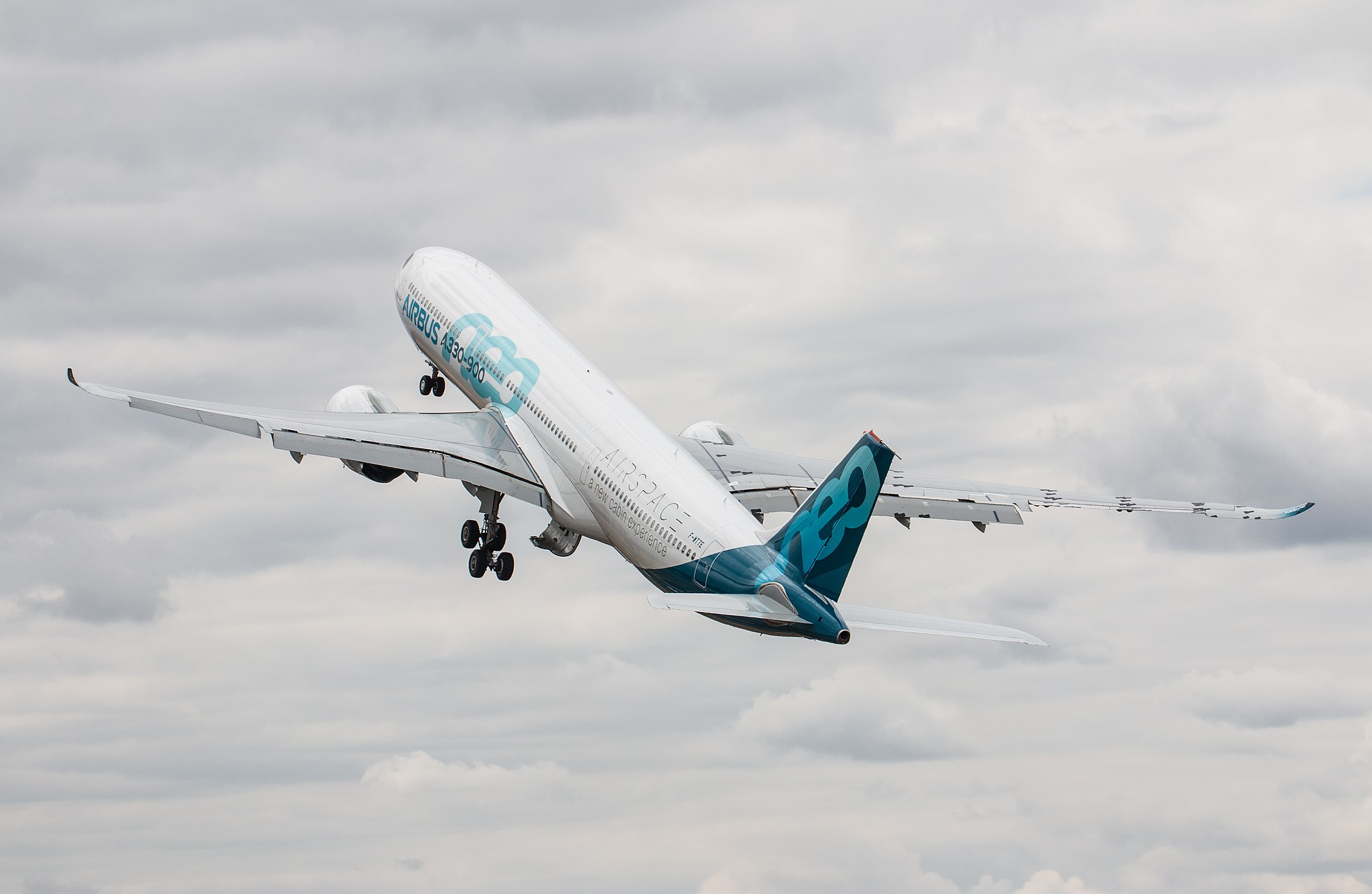End of the year feature article highlights 17 first flights from 2017 and includes videos of each aircraft in a comprehensive list—aviation industry sees a variety of fixed-wing and rotary-wing aircraft take their maiden voyage over the course of the past year
At WinAir, we love end of the year lists—particularly those that focus on the achievements of the aviation industry. They provide us with the opportunity to look back on the many milestones reached by aircraft manufacturers, airlines, aerospace companies, etc., and leave us with a feeling of excitement as we head into the New Year. In 2017, there were a plethora of significant aviation accomplishments that were reached by a variety of influential organizations.
In order to hone our focus, we’ve decided to shine the spotlight upon those aircraft that have reached the momentous occasion of completing their inaugural flight in 2017. Our 17 first flights from 2017 list, presents a series of airplane, helicopter, and other new aircraft types that have successfully completed their aircraft’s first flight in 2017. For each aircraft mentioned, a corresponding video is attached. Unique aircraft types worth noting on this year’s list include a tiltrotor aircraft, an experimental aircraft, a Vertical Take-off and Landing (VTOL) jet, a rotary-wing unmanned aerial vehicle (UAV), an unmanned reconnaissance helicopter (drone), and an electric-powered rocket.
So without any further delay, here are 17 first flights from 2017, displayed in chronological order:
- Embraer E195-E2 – First Flight – March 29th, 2017
The E195-E2 (EMB 190-400) is the largest variant of the Embraer E-Jet E2 family, and is set to compete with the Bombardier CS100.1
- Airbus A319neo – First Flight – March 31st, 2017
The Airbus A319neo (“neo” for “New Engine Option”) made its first flight on 31 March 2017, powered by LEAP Engines but Pratt & Whitney Engines are also available.2
- Antonov/Taqnia An-132 – First Flight – March 31st, 2017
The Antonov/Taqnia An-132 is an improved version of the Antonov An-32 twin-engined turboprop military transport aircraft.3
- Boeing 787-10 – First Flight – March 31st, 2017
According to Boeing, the 787-10 is slated to compete against the Airbus A350-900—At the start of the November 2017 Dubai Air Show the 787-10 had 171 orders.4
- Boeing 737 MAX 9 – First Flight – April 13th, 2017
The Boeing 737 MAX 9 will replace the 737-900 and should be certified in early 2018, with the plane scheduled to enter service in the first quarter of the New Year.5
- Lilium Jet – First Flight – April 20th, 2017
Lilium is a vertical take-off and landing (VTOL) jet designed and manufactured by aircraft manufacturing company Lilium Jet.6
- Comac C919 – First Flight – May 5th, 2017
The Comac C919 is a narrow-body twinjet airliner developed by Chinese aerospace manufacturer Comac—It is intended to compete with the Boeing 737 MAX and “Airbus A320neo.7
- Lockheed Martin LM-100J – First Flight – May 25th, 2017
The Lockheed L-100 Hercules is the civilian variant of the C-130 Hercules military transport aircraft made by the Lockheed Corporation.8
- Irkut MC-21 – First Flight – May 28th, 2017
The Irkut MC-2 is a Russian single-aisle twinjet airliner, developed by the Yakovlev Design Bureau and produced by Irkut, both of which are United Aircraft Corporation subsidiaries.9
- VSR700 – First Flight- May 28th, 2017
The VSR700 is an unmanned reconnaissance helicopter currently being developed by Airbus Helicopters and DCNS.10
- Rocket Lab’s Electron Rocket – First Flight – May 28th, 2017
Electron is a two-stage launch vehicle that uses Rocket Lab’s Rutherford liquid engines on both stages—the engines use pumps that are uniquely driven by battery-powered electric motors.11
- Dassault Falcon 5X – First Flight – July 5th, 2017
The Dassault Falcon 5X is a large, long-range business jet developed by Dassault Aviation in France.12
- Lancair Mako – First Flight – July 18th, 2017
The four-seat composite Mako is an experimental alternative to the Cirrus SR22 or Cessna TTx.13
- Indonesian Aerospace N-219 – First Flight – August 16th, 2017
The Indonesian Aerospace N-219 is a twin-engine, 19-seat transport aircraft designed by Indonesian Aerospace for multi-purpose missions in remote areas.14
- Scaled Composites 401 – First Flight – October 11th, 2017
The Scaled Composites 401 is an American experimental aircraft, designed and produced by Scaled Composites—The two examples that the company built were constructed to demonstrate “advanced, low-cost manufacturing techniques” for the production of research aircraft for both industry and government.15
- Airbus A330neo-900 – First Flight – October 19th, 2017
The Airbus A330neo is a wide-body jet airliner currently under development by Airbus.16
- Bell V-280 Valor – First Flight – December 18th, 2017
The Bell V-280 Valor is a tiltrotor aircraft being developed by Bell Helicopter and Lockheed Martin for the United States Army’s Future Vertical Lift (FVL) program.17
Aviation Technology and Aviation Industry Advancing at a Rapid Pace
Upon reviewing this year’s first flight achievements, it seems unmistakably clear that the aviation industry is evolving at a rapid pace. What’s driving this transformation? Fundamentally, it has a lot to do with the industry’s adoption of new technologies and the application of new software solutions.
Advancements in technology are allowing aircraft manufacturers to develop faster, lighter, and more robust aircraft. As a result, the aviation industry can expect to experience monumental shifts in the way it does business throughout 2018 and it’s safe to say that this trend will continue in the coming years.
At WinAir, we know all about the concept of advancing technology for the purpose of streamlining and expediting processes at aviation operations. After all, it’s been a chief interest from day one.
For nearly 30 years now, WinAir has been on the forefront of technological advancements in the aviation maintenance industry, and a leader in aviation management software. Contact us today to discover first-hand, how WinAir will propel your aviation operation to new heights!
References:
- Wikipedia contributors. “Embraer E-Jet E2 family.” Wikipedia, The Free Encyclopedia. Wikipedia, The Free Encyclopedia, 18 Dec. 2017. Web. 21 Dec. 2017.
- Wikipedia contributors. “Airbus A320neo family.” Wikipedia, The Free Encyclopedia. Wikipedia, The Free Encyclopedia, 20 Dec. 2017. Web. 21 Dec. 2017.
- Wikipedia contributors. “Antonov/Taqnia An-132.” Wikipedia, The Free Encyclopedia. Wikipedia, The Free Encyclopedia, 8 Nov. 2017. Web. 21 Dec. 2017.
- Wikipedia contributors. “Boeing 737 MAX.” Wikipedia, The Free Encyclopedia. Wikipedia, The Free Encyclopedia, 21 Dec. 2017. Web. 21 Dec. 2017.
- Wikipedia contributors. “Boeing 737 MAX.” Wikipedia, The Free Encyclopedia. Wikipedia, The Free Encyclopedia, 21 Dec. 2017. Web. 21 Dec. 2017.
- Wikipedia contributors. “Lilium (aircraft).” Wikipedia, The Free Encyclopedia. Wikipedia, The Free Encyclopedia, 5 Dec. 2017. Web. 21 Dec. 2017.
- Wikipedia contributors. “Comac C919.” Wikipedia, The Free Encyclopedia. Wikipedia, The Free Encyclopedia, 18 Dec. 2017. Web. 21 Dec. 2017.
- Wikipedia contributors. “Lockheed L-100 Hercules.” Wikipedia, The Free Encyclopedia. Wikipedia, The Free Encyclopedia, 30 Oct. 2017. Web. 21 Dec. 2017.
- Wikipedia contributors. “Irkut MC-21.” Wikipedia, The Free Encyclopedia. Wikipedia, The Free Encyclopedia, 21 Dec. 2017. Web. 21 Dec. 2017.
- Wikipedia contributors. “VSR700.” Wikipedia, The Free Encyclopedia. Wikipedia, The Free Encyclopedia, 2 Mar. 2017. Web. 21 Dec. 2017.
- Wikipedia contributors. “Rocket Lab.” Wikipedia, The Free Encyclopedia. Wikipedia, The Free Encyclopedia, 17 Dec. 2017. Web. 21 Dec. 2017.
- Wikipedia contributors. “Dassault Falcon 5X.” Wikipedia, The Free Encyclopedia. Wikipedia, The Free Encyclopedia, 14 Dec. 2017. Web. 21 Dec. 2017.
- Flying Magazine. (2017). Lancair Shows Off Four-Seat Mako at AirVenture. [online] Available at: https://www.flyingmag.com/lancair-shows-off-four-seat-mako-at-airventure [Accessed 21 Dec. 2017].
- Wikipedia contributors. “Indonesian Aerospace N-219.” Wikipedia, The Free Encyclopedia. Wikipedia, The Free Encyclopedia, 22 Nov. 2017. Web. 21 Dec. 2017.
- Wikipedia contributors. “Scaled Composites 401.” Wikipedia, The Free Encyclopedia. Wikipedia, The Free Encyclopedia, 7 Nov. 2017. Web. 21 Dec. 2017.
- Wikipedia contributors. “Airbus A330neo.” Wikipedia, The Free Encyclopedia. Wikipedia, The Free Encyclopedia, 12 Dec. 2017. Web. 22 Dec. 2017.
- Wikipedia contributors. “Bell V-280 Valor.” Wikipedia, The Free Encyclopedia. Wikipedia, The Free Encyclopedia, 19 Dec. 2017. Web. 21 Dec. 2017.
- (Blog Feature Image) Steve Lynes from Sandshurst, United Kingdom [CC BY 2.0 (https://creativecommons.org/licenses/by/2.0)], via Wikimedia Commons
About WinAir:
Based in London, Ontario, Canada, WinAir has 30 years of experience as a leader in aviation management software. Companies rely on WinAir to efficiently and effectively track and manage aircraft maintenance and inventory control. WinAir is proud to lay claim to hundreds of installations at aviation-specific organizations worldwide. From airlines, to heli-ops, to law enforcement agencies, oil industry suppliers, MROs, CAMOs, medical evacuation response teams and more, businesses using WinAir regard the solution as a necessary component to the successful management of their fleet maintenance programs.





